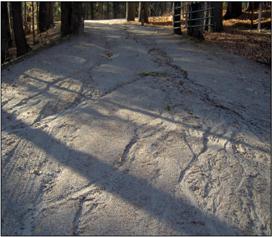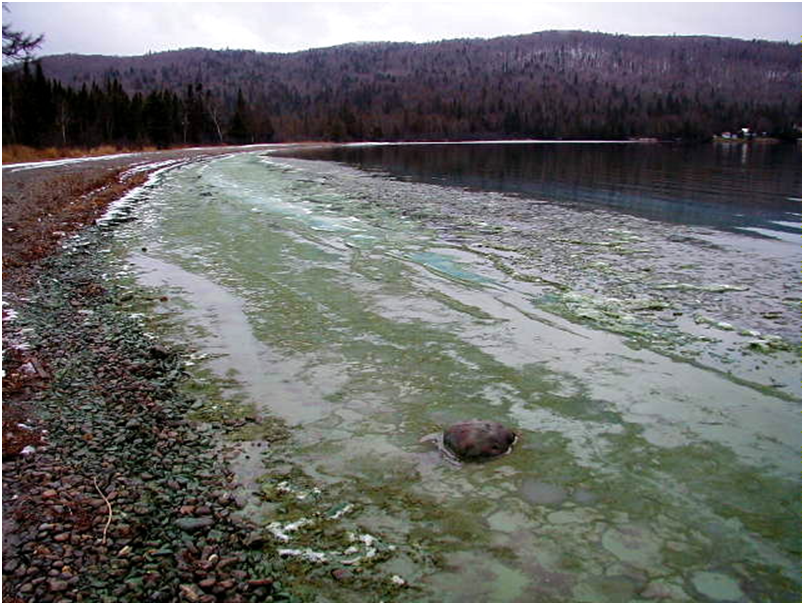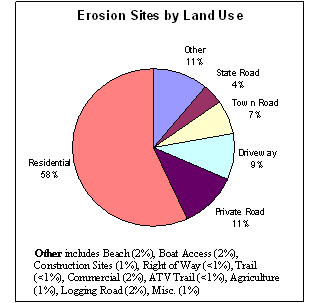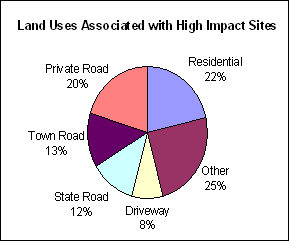Home → Land Resources → Watershed → Shorefront Property Owners Information → Unpaved Roads → Impact of Unpaved Roads
 Impact of Unpaved (Dirt, Camp) Roads on Water Quality
Impact of Unpaved (Dirt, Camp) Roads on Water Quality
Many camp roads were either not properly constructed, or not properly maintained, or both. Because of this, rain and melting snow runoff can cause material from the road to erode into a nearby stream or lake. Dust from wind and vehicular use can also deposit a large amount of road sediment into nearby bodies of water.
How Do Camp Roads Impact Water Quality?
Camp roads frequently change natural stormwater drainage patterns. These changes can increase the potential for soil erosion by:
- reducing the ability of water to soak into the ground by stripping away the protective vegetative cover
- creating highly erodible pathways of exposed soils
- collecting drainage on the road and in ditches, increasing the overall flow, speed and volume of the runoff
 What's the Problem with Soil Erosion?
What's the Problem with Soil Erosion?
When you see the water turn brown, soil has been eroded into the lake.
This suspended sediment can:
- irritate the gills of fish, making them prone to disease
- smother fish spawning and feeding grounds
- gradually fill in near shore, resulting in the loss of desirable shoreline (due to encroaching weeds, for instance)
- cause algal blooms, resulting from the attached phosphorus
- reduce levels of dissolved oxygen, resulting in fewer cold-water fish (i.e., salmon and trout)
- diminish recreational and aesthetic values of the lake
What Does Phosphorus Have to Do with Sediments?
Nutrients, such as phosphorus, are attached to camp road sediments.
Phosphorus, a nutrient that is common on land, is a primary food for all plants, including algae. In natural conditions, the scarcity of phosphorus in a lake limits algal growth. However, when a lake receives extra phosphorus in the form of camp road sediment, algal growth increases dramatically. Sometimes this growth causes choking algal blooms, but more often it results in small, negative changes in water quality that, over time, damage the health and aesthetics of the lake.
How Much of an Issue are Camp Roads Really?
Improper construction and maintenance of camp roads has long been recognized as a significant issue in lake watersheds. While other development activity, such as building construction, is often a source of soil erosion, building sites are eventually stabilized and pose less of a threat over the long run than roads, which are often subject to on-going problems.
Camp roads contribute a disproportionate amount to lake water quality problems due to their proximity to the water and due to their sub-standard construction, which is largely because most camp roads were originally intended to only provide seasonal access.
Lake Watershed Survey Results Review
Lake watershed surveys help the Department and local communities identify specific pollution problems namely in the form of eroding soil to Maine lakes. During watershed survey projects, trained volunteers and technical staff walk all roads and developed areas in a watershed and document soil erosion problems.
To determine the most prevalent soil erosion sources and problems in lake watersheds, the DEP completed an analysis of 36 lake watershed survey projects that were completed with technical oversight from the Maine DEP over the past decade.
Review Findings:
Overall, residential areas (58%) accounted for the largest number of problems. Private roads accounted for the second highest number of problems (11%). Grouped together, road issues (state, town and private roads and driveways) accounted for 31% of the erosion sites.

Although there were fewer road sites compared with residential sites, road sites tended to be rated as higher impact problems. Of the 480 high impact sites identified, 255 (53%) resulted from town, state, and private roads and driveways.
